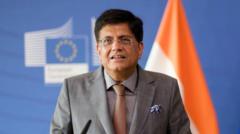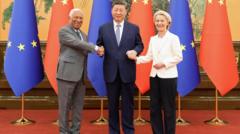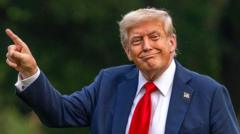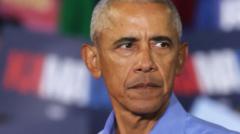Despite concerns over rising tariffs, President Trump's hardline trade tactics are yielding results with Japan, marking a significant milestone that could influence negotiations with other nations. While US consumers may face higher costs, the agreement aims to mitigate some trade tensions in the global economy.
Trump’s Trade Tactics Show Promising Signs with Japan Deal
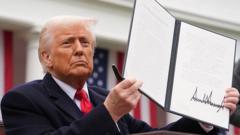
Trump’s Trade Tactics Show Promising Signs with Japan Deal
The recent trade agreement between the US and Japan highlights the potential success of President Trump's tariff strategies, as it may set a precedent for negotiations with other economic powers.
Japan's latest trade agreement with the United States signals a triumph for President Donald Trump’s aggressive trade policy, which may have implications far beyond the bilateral relationship. Following months of tense negotiations, the two countries have reportedly reached an agreement that highlights Japan's willingness to compromise under significant economic pressure.
Historically, Japan has been a crucial player in international trade discussions, and this recent deal showcases the importance of its collaboration with the US. The agreement will impose a general tariff of 15% on Japanese imports, higher than the 10% faced by the UK, which, notably, does not have a trade surplus with the US.
Negotiations have reportedly been fraught, with Japanese officials exhibiting frustration amid the polite demeanor typically associated with their diplomatic approach. This deal could be viewed as a strategic victory for Trump's administration, especially if it influences similar negotiations with other major economies, including the European Union.
As Japan scrambles to secure favorable trade terms, concerns linger about their significant holdings in US Treasury bonds. The Japanese finance minister's remarks regarding these assets underscore the potential leverage that Japan possesses in the face of Trump's aggressive tariff policies. The revelation of continued discussions comes at a time when the US risks trade fragmentation with allies like Canada and the EU, which may also be feeling pressure to formulate responses to the evolving landscape.
The implications of the trade agreement extend to agriculture, as Japan has skillfully negotiated protection for its local market while increasing imports of US rice. Interestingly, Japanese consumers remain hesitant about American automobiles, indicating that this deal may not fully bridge the trade gap.
Significant to note is Japan’s strategic timing; they opted to take action now rather than awaiting the full effects of Trump’s planned tariffs on numerous countries. This decision may reflect internal political considerations, as Prime Minister's leadership faces scrutiny.
Currently, US tariffs are generating substantial revenue for the Treasury, contributing an estimated $100 billion to federal finances this year alone, a notable increase from historical patterns. Treasury Secretary Scott Bessent projects that this figure could reach $300 billion annually, highlighting tariffs as a growing source of income, despite the absence of formidable retaliatory measures thus far.
Nevertheless, the question remains: who ultimately bears the brunt of these tariffs? Most analysts agree that American consumers will see increased prices for imported goods as a result. Compounding this issue is the decline of the US dollar, which has lost 10% of its value in the first half of the year, further driving up the cost of imported goods.
The broader market context suggests a shifting perception of the US dollar’s stability as a safe haven currency, with indications that concerns about its declining value may indeed serve to bolster domestic manufacturing positions.
While the agreement with Japan is a notable step for the Trump administration’s trade agenda, it raises questions regarding the sustainability of such policy initiatives and their broader economic consequences. As the landscape of global trade continues to evolve, attention turns to how forthcoming negotiations might unfold, particularly with other influential economies.



